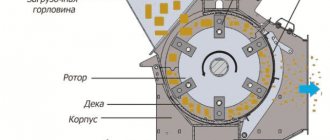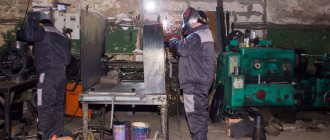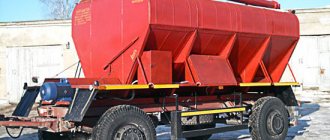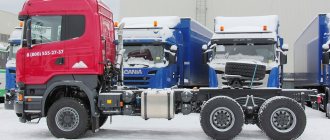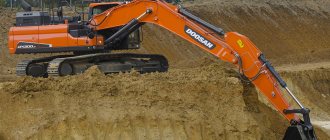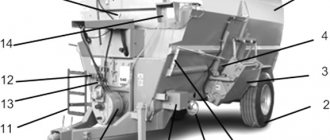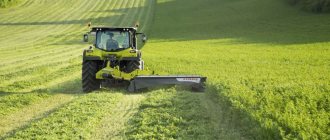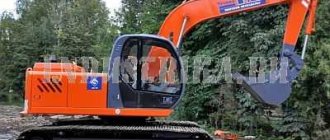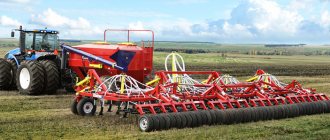- What is an extruder?
- What is a granulator?
- Which is better - an extruder or a granulator?
For the production of compound feed, two devices that are similar in function but different are used – an extruder and a granulator. Each of them has its own advantages and disadvantages. Which is better, a granulator or an extruder, can only be understood after analyzing all the information about both devices. Therefore, when choosing a device, you should decide in advance what equipment you need, carefully weigh the pros and cons of the extruder-granulator pair, and learn all about the differences between them.
Grain extruder
Today, many grain processing processes are carried out using special equipment, which is designed to improve the quality characteristics of grain.
Such equipment is a grain extruder. This device is simply indispensable in the process of grain processing, since extruded grain has a lot of useful qualities, for example, it is very important to use the extruder before feeding the grain into animal feed. The fact is that this equipment performs almost half the work of the animal’s stomach, thus, the assimilation process occurs at a 100% level. And this, in turn, affects animal performance, such as milk yield, as well as improving animal health. An important factor is that through processing in an extruder, the grain is sterilized, and this makes it possible to ensure longer preservation of the product, regardless of external conditions, and to neutralize it from parasites. In simpler terms, the main purpose of the extruder is to double the nutritional value of the product.
The extrusion process itself is not complicated, everything is done by the machine itself. Initially, grain crops or other raw materials intended for extrusion are dispensed into a special hopper for loading. Next, the grain, using a special vibrating feeder, is dispensed through a funnel for receiving raw materials into the working element of the extruder installation. The grain output is regulated by changing the oscillation frequency in the vibrating feeder.
Which is better - an extruder or a granulator?
To answer this question, it is necessary to compare the advantages of both devices. If you need a device that most fully preserves the original properties of the raw material, then a granulator is better. The extruder uses heat and high pressure. This has a significant impact on the initial characteristics of the material, as well as on the price of the equipment. The device is widely used in large and small farms. But you need to take into account that the price of high-performance equipment can be quite high, and not everyone can afford it.
At the same price, granulators have higher productivity. This is the main argument in their favor. Other advantages of the device:
- simplicity, ease of use;
- high quality ready-to-use product;
- significant reduction in the production cycle;
- the possibility of recycling waste and creating waste-free production;
- small pellet sizes, easy storage.
All these advantages indicate that when choosing equipment for mass production of feed for a large farm or sale, you should still prefer a granulator. In addition, today automated lines are produced that can produce granules in huge quantities.
You can order and purchase high-quality equipment or feed production lines for your own business, as well as any spare parts, on our website. Managers of the online store will answer the question of what a granulator is and give advice on payment and delivery of equipment.
Cereal extruder design
A special magnetic collecting element is built into the receiving funnel to select metal particles that can enter the extruder along with grain crops. In the working body of the grain extruder itself, the mass is forced through the forming die. The productivity of the equipment can be different, and varies from eighty to one hundred kilograms of grain produced per hour of operation of the installation.
The extruder design consists of such important working elements as an electric motor and a hopper for loading raw materials into it. The extruder design also includes a bearing unit, which is equipped with two bearings, and a special tray. Loading of grain into the receiving hopper occurs through the operation of a special loading-type neck with an adapted watering can. Thus, grain leakage during loading into the machine is minimized.
The operating principle of a grain extruder
A grain extruder is equipped with a special chamber in which grain and other raw materials are pressed; it is during the pressing process that the grain seems to explode from the inside. This processing of grain makes it more nutritious for animals; the principle of operation of the pressing chamber is similar to the production of popcorn. That is, the grain becomes more airy and more easily digestible by animals.
Screw elements of the feeding, intermediate and pressing type are mounted on a special shaft. Special rings are installed between these elements, which press the grain crop. At the end of this mechanism there is a cone-shaped pressing element. On the shaft on the side where the device drive is located, there is a mechanism that moves the tray into the pulley.
The use of grain extruder in agricultural activities and farms is of great importance. Firstly, it is beneficial from an economic point of view; there is no over-consumption of grain when feeding animals. The grain extrusion process occurs quite quickly, which allows achieving a high level of productivity. This technique is used both in large industries and in private farms.
conclusions
The extruder wins with a score of 6:3. But as always, to each their own. And for example, in woodworking it is certainly more profitable and better to use granulators for processing large volumes of feed, and roller presses are also better. But extruders are more profitable for home use.
I think that everyone today will agree with me that granulators are much more common than extruders. Therefore, I will join the majority and conclude that the granulator is better than the extruder, although it wins with a score of 6:3. Well, in the end, it’s up to you to make a conclusion about purchasing this or that machine based on this information!
Extruder. Types and device. Operation and application. Peculiarities
An extruder is a machine for the production of long products from plastic or bulk substances. The device forces the loaded materials through a thin hole under high pressure, sometimes with preheating, which causes the substance to compact. Such machines are widely used in various fields of production.
Where is the extruder used?
Extruders have found wide application in various branches of modern industry. They are used for the production of:
- Animal feed.
- Chocolate bars.
- Pasta products.
- Wires for 3D printers.
- Plastic pipes.
- Profiles made of polyvinyl chloride.
- Polyethylene film.
- Fuel briquettes.
Extruder-type equipment is found everywhere. The production of granulated animal feed, as well as pasta, long hollow plastic products, etc. could not be done without it. The systems used for certain purposes have slight differences in technical terms, but work on the same principle.
Types of extruders based on operating principle
Based on their operating principle, extruders are divided into 3 types:
- Screw.
- Plunger
- Flat-slit.
Screw
extruder is the most common. It works on the principle of a meat grinder. Inside the device there is a rotating screw with a spiral that grabs the loaded material and pushes it through a thin hole. As a result, the mass becomes compacted and becomes hard. The pressure created raises the temperature of the raw material, which increases the efficiency of welding components. These types are the cheapest compared to others. In addition to the single screw design, twin screw extruders are also available. They create even more efficient compression, but are also more expensive. Such devices are usually used for the production of feed, as well as various food industry products.
Plunger
extruders, unlike screw extruders, accurately dose the material before giving it a specific shape. Similar devices are used for processing rubber or plastic.
Flat slot
extruders are designed for the production of rolled products such as stretch film, greenhouse film, plastic and propylene sheets. In them, the heated and viscous material is squeezed out through a flat, wide slot and quickly cools, as a result of which it retains its shape. The material is supplied using a hydraulic press, auger, or other mechanism.
Feed extruders
Feed extruders are usually represented by equipment with a screw design. They are designed for processing grain crops and herbaceous plants into compound feed. There are two types of such systems. The first simply carries out extrusion, giving a long tube at the output, and the second creates finished granules.
Conventional extruders
Conventional extrusion processes whole grains into a long, crisp tube that can be crushed into flakes. Such feed is more acceptable than raw materials loaded for processing. The fact is that as a result of compression, the mass is heated. This helps to destroy the vast majority of microorganisms that can cause eating disorders. In addition, the nutrients are baked as if in an oven, which improves their absorption by the animal’s body.
Choosing a feed granulator
To choose the right feed granulator, you must calculate the future production capacity in advance
.
Since this device is key to the entire granulation line, you should not skimp on its purchase. For an industrial line, not only the efficiency of the press is important, but also the availability of spare parts
for it - first of all, dies and press rollers. Therefore, it is risky to order equipment from abroad: given the foreign policy situation, the supply of spare parts may be interrupted, and their cost may rise sharply.
A feed pellet mill is not a standard purchase. Reliable manufacturers of granulators in Russia offer a full service for selecting a device of the required power, setting it up, and bringing it to the required power when working with feed mixtures. The matrix plays an important role
: quality of steel, length of the working channel (or compression ratio), quality of internal grinding of holes.
Household pelletizers are usually not specialized by the type of raw material. The same devices can be used for pelleting feed and pellets. Mini-pellet mills are purchased by owners for private needs, since the feed pellets produced from them have a short shelf life and break down during transportation and frequent pouring. It is generally not recommended to produce pellets using mini-granulators, because... the granules are of very low quality
Extruder for feed: drawings and useful recommendations
A simple to use feed extruder makes it possible to independently produce compound feed for animals. This device is considered an indispensable assistant both in large-scale agriculture and in small farms for raising animals and birds. In specialized stores, such equipment costs decent money. To save money, you can assemble the unit yourself; drawings and recommendations from specialists will serve as an auxiliary informant in this matter.
My services
For anyone who wants to buy equipment for production, it is usually necessary to collect a sufficient amount of information. I offer my services in selecting equipment, selecting productivity, drawing up a business plan, drawing up a technological work process, and ENplus certification. For more information about my services, see the “SERVICES” section in the top menu.
In addition to my services, I constantly publish new and interesting books on this topic. The books are not at all expensive; more details about them can be found in the “BOOKS” section in the top menu. For example, the latest and very recent book “Typical mistakes of equipment manufacturers when planning pellet production.”
It provides a number of recommendations for planning modern production with a minimum number of staff and the most important parameters of production automation. It also provides information on the preparation of raw materials and storage of granules.
What it is
An extruder is used to process grain crops into compound feed, which is much easier to digest in the stomach of animals. Processing is carried out using a press under a pressure of 60 atmospheres and at high temperature. The result is a product shaped like 20-30 mm corn sticks, but with a dense structure.
Apparatuses for preparing feed exist with different power ratings, and the volume of product produced depends on it. For a small farm, a device with a productivity of 25-45 kg/h is perfect - the price of such a device starts from 47 thousand rubles. But a large farm will require more powerful models capable of producing up to 1.5 tons per hour and they cost from 160 thousand rubles.
Granulator - what is it?
A granulator is a device designed for the production of a special type of feed - pressed granules. They are also called pellets in another way. The granulation process is carried out by clumping finely dispersed, that is, pre-crushed, cleaned, moistened raw materials containing adhesive substances.
The production of granulated feed consists of the following stages:
- grinding of primary material;
- drying;
- moistening raw materials to the desired condition;
- re-grinding of raw materials; production of granules with compaction.
These processes occur as follows. The crushing of raw materials occurs in a crusher. Drying is carried out in an aerodynamic dryer. The required degree of moisture of the substance is achieved by treatment with hot steam.
The answer to the question of which feed granulator is better can only be obtained after comparing the characteristics of the devices. Since the devices differ in power and design, it all depends on which granulator best meets the buyer's requirements.
The most common type of equipment is granulation presses, consisting of a main frame, a container with a door, and a press. The granulation process includes:
- entry of the primary substance into the mixing device;
- obtaining a rope-shaped mass by squeezing out the finished mixture using rollers;
- cutting and cooling of finished granules.
It is noteworthy that granulators can be used to produce fuel pellets.
Benefits of using a grain extruder
A grain extruder is one of the most significant devices for improving the quality of grains. The need to purchase it is justified by many factors. The extruder allows you to increase the quality characteristics of grains several times. Feed processed with an extruder is more economical, easier to digest and completely safe.
This technology is used both in agriculture, helping to significantly reduce feed consumption, and in the food industry to improve the quality of the final product.
Extrusion is by far the most effective way to increase the nutritional value of grains!
Description
Grain extruders are intended for the rapid production of feed, the digestibility of which is 90-95%, while the digestibility of unprocessed grain does not exceed 65%.
As a result of a short-term increase in temperature, as well as mechanical stress and artificial pressure changes, structural and chemical changes occur in the grain .
Starch, which makes up 50% of grains and is quite difficult for animals to digest, and grain protein acquire a structure that is more easily accepted by the body.
Starch is broken down into simple sugars, complex proteins and carbohydrates are broken down into simple sugars, and fiber is converted into secondary sugars. Since the temperature effect lasts only a few seconds, beneficial vitamins and minerals are completely preserved, and fungi, pests and bacteria die.
Extruder operating principle
After the grain is fed into the bunker, the processes inside the apparatus take place without outside interference. Using vibration, the material is fed into the working area of the unit, where it is subjected to three-phase processing.
The processed material does not need to be steamed or subjected to any additional processing!
After entering the extruder, the grain undergoes heat treatment at temperatures from 110 to 160 degrees under pressure up to 40 atmospheres. When grain is released from this compartment, the pressure drops sharply, the water contained in the cells turns into steam and increases in volume 1000 times. As a result, an explosion occurs inside the grain, due to which it swells, acquires a porous structure, increases in volume and is better moldable.
After pressing through the profiling tool, a swollen strand emerges from the extruder, having the shape of a rope. If there is a cutter, the fraction size is approximately 10-50 mm.
The extrusion process occurs in approximately 30 seconds, which ensures high productivity with minimal energy consumption. Heating and compression of grain takes place without heating elements and hydraulics, only due to an electric motor.
Three extrusion methods are used:
- Cold forming;
- Warm processing;
- Hot extrusion.
No foundation is needed to install the extruder. It can be installed on any flat surface, even dirt floors!
Usage
Extruders are used to make animal feed.
The use of this technology can significantly reduce the cost of feeding animals. In addition, when animals are switched to feeding on extruded feed, the mortality of young animals is reduced. Feed made using extruders has the ability to prevent gastrointestinal diseases in animals and significantly improve the digestive process!
Extruders are also used in the food industry. They are used to make breakfast cereals, corn sticks, chips, crackers, baby food, and diet bread.
Twin-screw extruders are also used in the production of polymers: films for bags, polystyrene and polypropylene.
However, the most common use of an extruder is to improve the feeding qualities of grain crops. Any cereal crops, soybeans, and legumes can be used as materials for making feed.
After processing, the taste of grains is significantly improved due to the release of oils. The food acquires a pleasant aroma and bready taste. At the same time, animals eat faster.
Certain models of extruders allow you to process waste from meat and fish production. Extruders are also used to process oil-containing products before pressing. This process facilitates extraction and increases the final volume of oils obtained.
Extruder E-500
The device is intended for the production of animal feed and cleaning grains from harmful microorganisms. Also used for preparing soybeans, rapeseed, sunflower for oil extraction.
Using the device, you can process wheat, rye, corn, barley, peas, amaranth, lupine, soybeans and sunflower. A magnetic catcher of metal particles is installed in the extruder funnel, which avoids unnecessary impurities from entering the apparatus and, subsequently, into the feed.
Soybean processing capacity reaches 500 kg. per hour, when processing grains up to 300 kg. at one o'clock. In this case, the power consumption is 55 kW/hour.
- Length - 230 cm;
- Width - 210 cm;
- Height - 170 cm;
- Weight - 1400 kg.
A distinctive feature of this model is the presence of a humidification unit in the working area. This guarantees a soft and uniform grain processing process, and also reduces wear on working parts.
Extruder ES-1250
Powerful unit for use in large and medium-sized farms. The productivity of this model reaches 1250 kg/hour. At the same time, the extruder is able to work around the clock. Equipped with a side feed of raw materials from the bunker directly into the working area. This eliminates operational problems that are present when processing wet grain or complex mixtures in top-feed extruders.
In addition to standard materials for extrusion (wheat, oats, millet, barley), this model is suitable for processing biowaste, minced meat and bones, flour and other waste. The device is equipped with two hydraulic cylinders, which automatically remove the housings when disassembling the working part of the extruder or replacing screws. This greatly simplifies the long and labor-intensive process of maintenance and repair, especially in emergency situations. The extruder weight is 2130 kg and the power consumption is 110 kW.
This model allows you to adjust the gaps inside the working part of the extruder, making it possible to fine-tune the device for each raw material.
